Critters
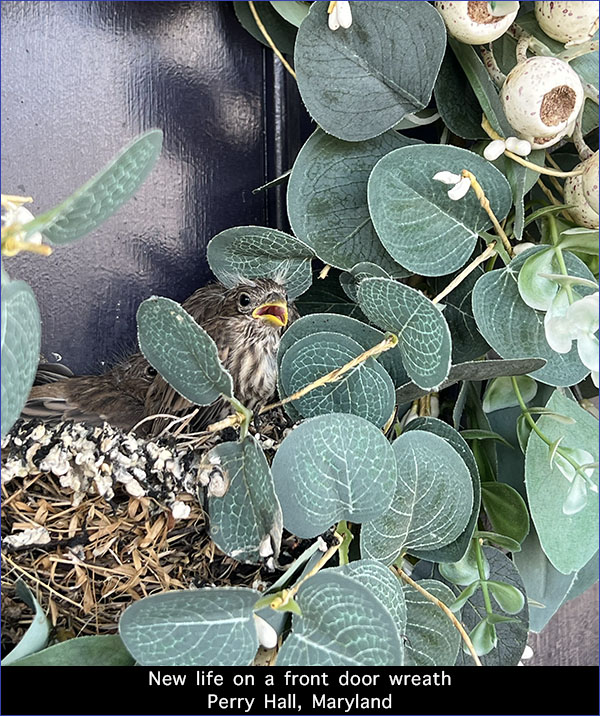
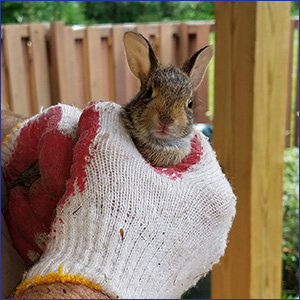 Rabbits—Even a baby can hop. When I picked it up, it screeched and then leapt into the air. But my gloved hands were the safety net. Once I clutched it, I rubbed its stomach to calm it down. The only movement it made over the next few minutes was the twitching of its nose and the blinking of its eyelids. Its ears were pronounced but when I had first seen it running through the mulch, I didn’t think it was a rabbit since its ears were laid down on its back. Rabbits like to graze and there was a grassy meadow nearby. There was also a patch of woods where I saw another rabbit hop to the safety of fallen trees and thick brush.
Rabbits—Even a baby can hop. When I picked it up, it screeched and then leapt into the air. But my gloved hands were the safety net. Once I clutched it, I rubbed its stomach to calm it down. The only movement it made over the next few minutes was the twitching of its nose and the blinking of its eyelids. Its ears were pronounced but when I had first seen it running through the mulch, I didn’t think it was a rabbit since its ears were laid down on its back. Rabbits like to graze and there was a grassy meadow nearby. There was also a patch of woods where I saw another rabbit hop to the safety of fallen trees and thick brush.
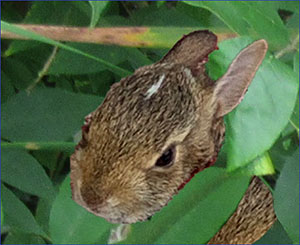 Chipmunks and squirrels are common sightings so I seldom stop to admire their meanderings. Rabbits being rare sightings are a treat. When I’d had my thrill of holding this baby, I placed it on the ground where it was initially hiding. It swiftly moved between two wooden fence panels. Then it crouched behind tallish grass. Talk about camouflage. Even behind the green grass, its brown fur was hard to find. When I tried to visit it minutes later, I stared at the grass patch for, oh 10 seconds until finally noticing the baby’s black, shiny eye.
Chipmunks and squirrels are common sightings so I seldom stop to admire their meanderings. Rabbits being rare sightings are a treat. When I’d had my thrill of holding this baby, I placed it on the ground where it was initially hiding. It swiftly moved between two wooden fence panels. Then it crouched behind tallish grass. Talk about camouflage. Even behind the green grass, its brown fur was hard to find. When I tried to visit it minutes later, I stared at the grass patch for, oh 10 seconds until finally noticing the baby’s black, shiny eye.
I’d read rabbits in the wild can carry rabies but of course me, the animal whisperer, never thought of that. And I didn’t fret about being bitten, figuring its teeth hadn’t yet matured into sharp weapons. I did feel its tiny claws at first but figured it was frightened being in a human’s grasp. Maybe my soft gloves comforted it. Then again, maybe it was the stomach massage I provided. I’m used to giving those since I have a Beagle at home.
 Raccoons—This mammal lives only 2–3 years so appreciate the sight if you see one. And no, they don’t have a black mask on their faces but two dark spots—one covering each eye. It’s the narrow brown marking down the center of its head, dark eyes and shiny black snout that make it look like a suspect in a hold-up.
Raccoons—This mammal lives only 2–3 years so appreciate the sight if you see one. And no, they don’t have a black mask on their faces but two dark spots—one covering each eye. It’s the narrow brown marking down the center of its head, dark eyes and shiny black snout that make it look like a suspect in a hold-up.
Their sharp claws allow them to climb structures and dig in the dirt for food. Adept hunters, they will pry open trash cans in search of our food scraps, as well as plants, fruit, insects or small mammals.
Their tails are ringed, and backs are humped. They seem to waddle as they crawl along with their snout near the ground, similar to the gait of a scent hound. Their coats are grayish, due to the mixture of black and white bristly fur.
National Geographic says the average raccoon weighs 14 pounds and is 2½-feet long. Mothers have litters of 1–7 cubs in early summer.
Deer—The spelling of the name is telling since these animals are not “dear” to gardeners or landscapers. Deer are herbivores chewing on and eating over 650 different kinds of plants, according to horticulturists who have studied their menus. Hosta is a deer’s garden salad. They devour the leaves but not the stems, making it look like the plant was electrocuted. Deer are ruminant, meaning they are mammals with stomachs having four chambers for storing and digesting food. A deer will regurgitate food to chew and digest it. Two thousand pounds of grasses and leaves are their yearly food intake.
 The Whitetail is the most common deer in northern Virginia. It’s so named for the white patch of fur on the underside of its tail—which shows while darting when startled. A deer stands about 5 feet tall. Does weight between 88 and 198 pounds while bucks (or stags) weigh 150–300 pounds.
The Whitetail is the most common deer in northern Virginia. It’s so named for the white patch of fur on the underside of its tail—which shows while darting when startled. A deer stands about 5 feet tall. Does weight between 88 and 198 pounds while bucks (or stags) weigh 150–300 pounds.
Deer mate (or rut) in October. Does birth a 3-fawn litter in May or June. Twins are common and sometimes, does have triplets. Fawns have over 300 spots on their hide which serve as camouflage. The white flecks disappear after a year. A fawn’s young legs lack the strength to keep up with their wandering mother or escape a predator. Luckily, fawns have no scent that might attract scavengers. A doe nurses her babies 2 to 4 times a day. She moves them—usually to another spot in high grass or weeds—for safety.
A buck’s antlers are bone covered with skin (velvet) which contains nerves and blood. Antlers are shed after a year and then regrown. Antler fragments are food for small rodents like chipmunks or squirrels and also fertilize the soil. The size of a buck’s ‘rack’ (with points called tines) depends on genetics and nutrition. Does typically lack antlers (only 1 in 10,000 have them). But reindeer (called caribou)—male and female—wear headsets (antlers).
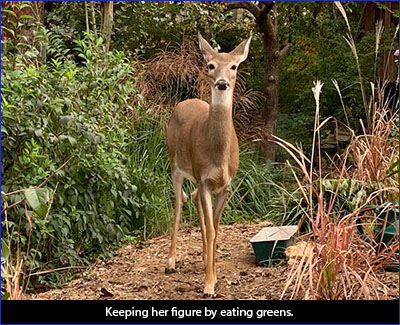 A deer’s eyes are on the sides of its head, giving it 360-degree vision. Its hearing is keen since it rotates its ears without even a move of its head. Reddish brown is the fur color which morphs to grayish brown in cold weather.
A deer’s eyes are on the sides of its head, giving it 360-degree vision. Its hearing is keen since it rotates its ears without even a move of its head. Reddish brown is the fur color which morphs to grayish brown in cold weather.
A deer can be fearless. I’ve approached them to within 10 feet before their brown-eyed stare diverts and they elegantly trot away on their two-hoofed feet. They will appear at dawn or dusk, either in herds or with their fawns. Deer live for 6 to 14 years. One can discern a deer’s age by tines on the antlers, a rounded rump or sagging stomach.
My thanks to National Geographic for these deer specifics.
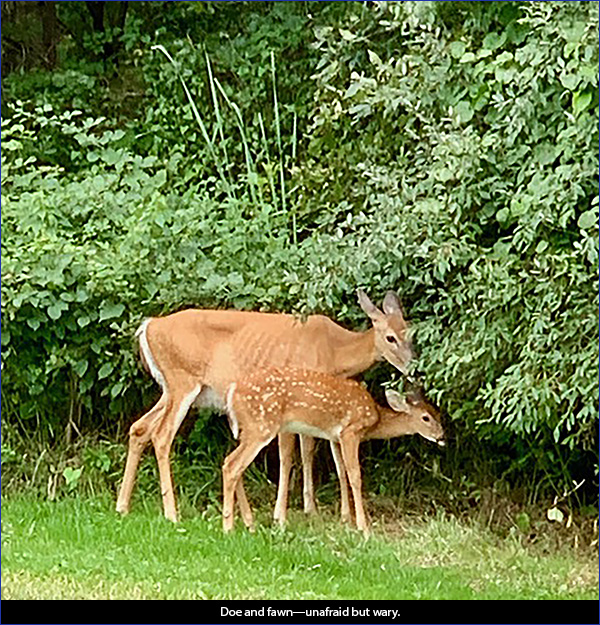
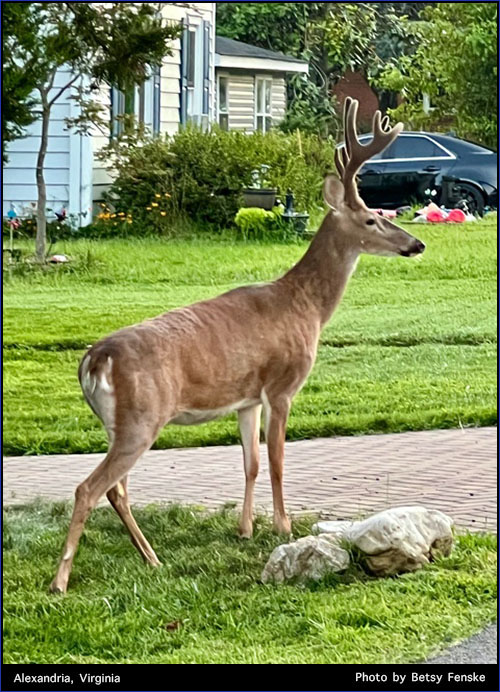
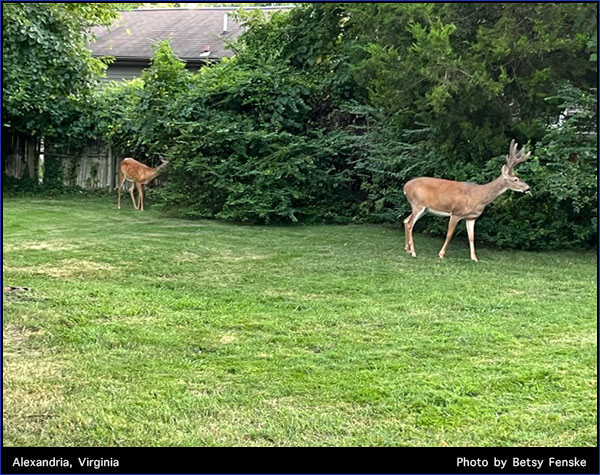
Red Fox (Vulpes vulpes)—Red Foxes are independent creatures, seldom seen in pairs or groups. They are solitary hunters—whether for prey or a vixen during mating season in autumn. There are wolf packs but not fox packs. It’s an adaptive mammal, living in mountain ranges, grasslands and even in suburbia.
And they are fearless. Years ago, I was walking my Beagles at night when I noticed a Red Fox ambling near an American Holly tree. My dogs stopped walking and stared. So did the fox. When I made kissing sounds toward it, the fox trotted toward me, stopped, looked at the three of us and turned around to continue on its route. Actually, we’d been on the fox’s radar for a block or so, given it can smell from afar.
Foxes are nocturnal. I saw proof of this when landscaping in Alexandria’s west end. I had cut down a small, ornamental tree and was carrying the trunk toward the woods. As I was stepping through a meadow of 2-foot-tall brush, I spotted something orange that looked like a discarded towel. It was a Red Fox (although the fur is orange), whom I just awakened from its nap. It spotted me and ran away. As I continued down my path, I noticed a depression in the grass where the fox had been lying.

The ‘red’ coat grows in just weeks after a kit is born—according to National Geographic (NatGeo)—which also reports the vixen gives birth to 2-to-12 pups in spring.
On the second tee of the East Potomac Park Golf Course in Washington, D.C., there is a massive mound of dirt covered in grass and tree saplings. Around its perimeter is tall brush. Red Foxes have been breeding here for years. On occasion, a fox will trot onto the fairway, pick up a golf ball in its mouth and scamper away. That counts as one penalty stroke.
A Red Fox has blackish forelegs and feet. On the inside of its pointed ears, there is both white and black fur. The tail is bushy and erect, pointing straight out like a fluff of cotton candy. The National Wildlife Federation says this gives the animal balance—similar to an aircraft’s rudder, which controls movement during flight.
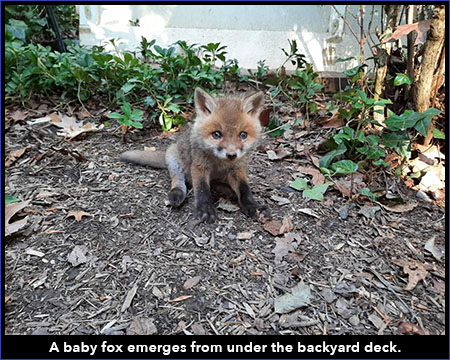
The tip of the Red Fox’s tail is white—like the Beagle—and will swish it back and forth to warn mates of a nearby threat. The Red Fox’s tail is about three-quarters the length of its body. The irises of its eye match its rust-colored fur. Its snout is long and pointed with orange fur on atop and whitish fur along its mouth, chin and chest. This beautiful animal lives an average of just three years, reports NatGeo.
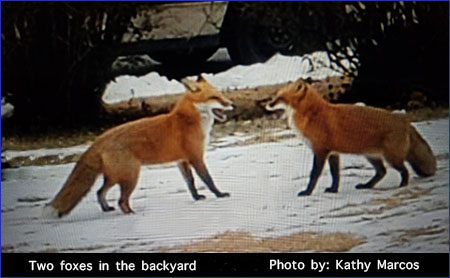
But the Red Fox lives on in the metaphors we use: sly as a fox...fox trot (dance)...foxy lady (remember those 70s ladies’ T-shirts—the ones with the glitter and sparkly lettering?)...clever as a fox...den mother (Cub Scouts)...cunning as a fox...fickle as a fox...sly old fox...outfox.
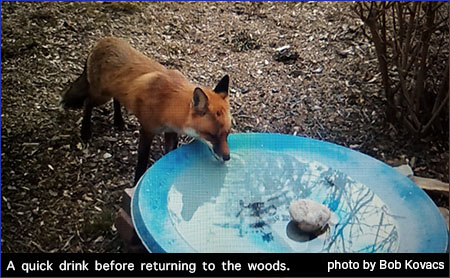
 Mantis (Mantid or ‘Praying Mantis’)—So named for its bent forelegs, a posture it keeps when at rest ... these serrated legs will extend to grab prey ... they can be a lime green or brown or both ... its camouflage is its security blanket ... you may be able to grasp one but it will opt to scurry away ... it eats insects and hummingbirds ... its main adversary is the bat; ... it eats beetles, spiders and crickets ... it is a beneficial farming insect.
Mantis (Mantid or ‘Praying Mantis’)—So named for its bent forelegs, a posture it keeps when at rest ... these serrated legs will extend to grab prey ... they can be a lime green or brown or both ... its camouflage is its security blanket ... you may be able to grasp one but it will opt to scurry away ... it eats insects and hummingbirds ... its main adversary is the bat; ... it eats beetles, spiders and crickets ... it is a beneficial farming insect.
 Mosquito—Feeds on flower nectar, while only the female sucks the blood from birds, reptiles, amphibians and mammals, including us ... the female requires protein in the blood for its egg development ... the insect evolved in South America ... a mosquito bite can breed malaria and West Nile virus ... to retard mosquito populations, eliminate any standing water ... the female mosquito is attracted to the carbon dioxide in our exhaled breath and our perspiration ... it targets overweight males, especially those with Type ‘O’ blood.
Mosquito—Feeds on flower nectar, while only the female sucks the blood from birds, reptiles, amphibians and mammals, including us ... the female requires protein in the blood for its egg development ... the insect evolved in South America ... a mosquito bite can breed malaria and West Nile virus ... to retard mosquito populations, eliminate any standing water ... the female mosquito is attracted to the carbon dioxide in our exhaled breath and our perspiration ... it targets overweight males, especially those with Type ‘O’ blood.
 Chipmunk—Also called ground squirrels or red squirrels, they have a white stripe under and over the eye and a pattern of black and white stripes down the center of the back ... they store food in cheek pouches and hoard food for winter in soil burrows ... they eat nuts, bird eggs, insects, berries, mushrooms and seeds ... the rodent mates in spring and fall but hibernates during late fall and winter ... not known to carry rabies, their bites can still cause infection ... they are 5–6 inches long and weigh three ounces.
Chipmunk—Also called ground squirrels or red squirrels, they have a white stripe under and over the eye and a pattern of black and white stripes down the center of the back ... they store food in cheek pouches and hoard food for winter in soil burrows ... they eat nuts, bird eggs, insects, berries, mushrooms and seeds ... the rodent mates in spring and fall but hibernates during late fall and winter ... not known to carry rabies, their bites can still cause infection ... they are 5–6 inches long and weigh three ounces.
 Grasshopper—Their hind legs are longer and stronger than the front legs ... when stationary, the hind legs from an upside-down ‘V’ ... the female is larger than the male and lays between 400–500 eggs in a clutch ... she lays them in soil surrounded by a foamy substance which keeps them incubated ... she lays eggs in pods one-to-two inches underground, where they stay until the first hatchling crawls up to the soil surface in spring ... if the hind legs were stretched out, they would be longer than the grasshopper’s body ... Wikipedia says grasshoppers are eaten in Korea for protein.
Grasshopper—Their hind legs are longer and stronger than the front legs ... when stationary, the hind legs from an upside-down ‘V’ ... the female is larger than the male and lays between 400–500 eggs in a clutch ... she lays them in soil surrounded by a foamy substance which keeps them incubated ... she lays eggs in pods one-to-two inches underground, where they stay until the first hatchling crawls up to the soil surface in spring ... if the hind legs were stretched out, they would be longer than the grasshopper’s body ... Wikipedia says grasshoppers are eaten in Korea for protein.
 Monarch Butterfly—A fluttering stained-glass window, the Monarch is orange with black veins ... the female has thicker veins while the male has a spot in the center of each hind wing ... on the perimeter of its four wings, there are dotted patterns ... from August to October, the butterfly migrates to the southern United States, Cuba and Mexico and returns in spring ... they live only 6–8 weeks ... the female Monarch lays her eggs on the underside of the milkweed leaf, whose milky substance is food for the larvae ... Swedish botanist Carolus Linnaeus gave the perennial its Latin name, Asklepias, after the Greek demigod, for its healing ability due to folklore medicinal uses.
Monarch Butterfly—A fluttering stained-glass window, the Monarch is orange with black veins ... the female has thicker veins while the male has a spot in the center of each hind wing ... on the perimeter of its four wings, there are dotted patterns ... from August to October, the butterfly migrates to the southern United States, Cuba and Mexico and returns in spring ... they live only 6–8 weeks ... the female Monarch lays her eggs on the underside of the milkweed leaf, whose milky substance is food for the larvae ... Swedish botanist Carolus Linnaeus gave the perennial its Latin name, Asklepias, after the Greek demigod, for its healing ability due to folklore medicinal uses.
 Skink—Part of the Scincidae family, the largest in the lizard world with 1,200 species ... eight inches long with no neck and short legs ... tends to move like a snake, crawling and slithering ... their long, tapering tails are shed, then regenerated or voluntarily broken off through muscle contraction when attacked by prey or mishandled.
Skink—Part of the Scincidae family, the largest in the lizard world with 1,200 species ... eight inches long with no neck and short legs ... tends to move like a snake, crawling and slithering ... their long, tapering tails are shed, then regenerated or voluntarily broken off through muscle contraction when attacked by prey or mishandled.
 Box Turtle— Not a common sighting but you’ll see them on the road, golf course or in the woods ... live up to 100 years ... the young feed near water, adults on land ... typically charcoal with yellow-to-orange markings ... nesting period is from May to July ... incubation lasts about three months ... can be a dangerous food, since the turtle eats poisonous mushrooms and this can linger in their tissues ... omnivore.
Box Turtle— Not a common sighting but you’ll see them on the road, golf course or in the woods ... live up to 100 years ... the young feed near water, adults on land ... typically charcoal with yellow-to-orange markings ... nesting period is from May to July ... incubation lasts about three months ... can be a dangerous food, since the turtle eats poisonous mushrooms and this can linger in their tissues ... omnivore.
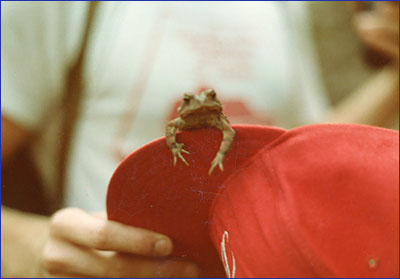 Frog—If the soil is moist or water is nearby, you may meet one of these leapers. We recently saw a two-inch frog in Alexandria and a four-inch frog in Potomac, Maryland. A toad’s signature markings are brown, pebbly skin and short hind legs. The brownish color is camouflage since it lives on land. A toad walks while the frog hops. The frog I held had a yellowish-olive belly with black swirls. A frog’s eyes actually bulge above the head. When they breathe, their throats puff out and then deflate. While croaking is the common call, the frog in Maryland chirped softly like a bird while in my hand. Pick one up between your thumb and forefinger and you’ll feel the softness of its abdomen. Wait a moment and you’ll feel their strength as they push out their elbows and hind legs to get free. Keep an eye on a frog and he’ll blink his eyes. The frog has three layers of eyelid membranes. One is transparent for underwater protection while the other two are translucent to opaque. According to “Wikipedia,” the frog is an amphibian of the order Anura, from the Greek, ‘an,’ and ‘oura’ meaning tail-less. The frog was formerly referred to as Salienta, from the Latin, ‘salfare,’ meaning to jump.
Frog—If the soil is moist or water is nearby, you may meet one of these leapers. We recently saw a two-inch frog in Alexandria and a four-inch frog in Potomac, Maryland. A toad’s signature markings are brown, pebbly skin and short hind legs. The brownish color is camouflage since it lives on land. A toad walks while the frog hops. The frog I held had a yellowish-olive belly with black swirls. A frog’s eyes actually bulge above the head. When they breathe, their throats puff out and then deflate. While croaking is the common call, the frog in Maryland chirped softly like a bird while in my hand. Pick one up between your thumb and forefinger and you’ll feel the softness of its abdomen. Wait a moment and you’ll feel their strength as they push out their elbows and hind legs to get free. Keep an eye on a frog and he’ll blink his eyes. The frog has three layers of eyelid membranes. One is transparent for underwater protection while the other two are translucent to opaque. According to “Wikipedia,” the frog is an amphibian of the order Anura, from the Greek, ‘an,’ and ‘oura’ meaning tail-less. The frog was formerly referred to as Salienta, from the Latin, ‘salfare,’ meaning to jump.
Birds
Below are some of the many flyers we've seen, some more visible than others.
 Cardinal—Both the male and female sing but are not migratory. Late in the afternoon, you will hear a “chip,” signaling the mate or as an alarm. Another call is “wacheer.” The male is larger and its black mask encircles the eyes and bill. The female’s mask is an arc just above her bill. Mate feeding will occur during breeding season, which is from March to September. The cardinal is the most common state (seven) bird in the United States: Illinois, Indiana, Kentucky, North Carolina, Ohio, West Virginia and Virginia. The Meadowlark is next, with six.
Cardinal—Both the male and female sing but are not migratory. Late in the afternoon, you will hear a “chip,” signaling the mate or as an alarm. Another call is “wacheer.” The male is larger and its black mask encircles the eyes and bill. The female’s mask is an arc just above her bill. Mate feeding will occur during breeding season, which is from March to September. The cardinal is the most common state (seven) bird in the United States: Illinois, Indiana, Kentucky, North Carolina, Ohio, West Virginia and Virginia. The Meadowlark is next, with six.
Blue Jay—If you collect bird feathers like we do, this is the most common plume you’ll find. The turquoise and black-striped feather comes from the lower back, wings and tail. Its’ call is common in our area. A screech-like, ‘jayer,” call, resembling a rusty gate slowly closing, is heard daily. This high-pitched “jayer” call is sounded to warn a mate of a predator, such as a Cooper’s Hawk, another common flyer in our area. Like the cardinal, the blue jay is found mainly in the central and eastern United States and southern Canada. Jays are not aerodynamic in flight but are aggressive to other birds and predators, especially cats.
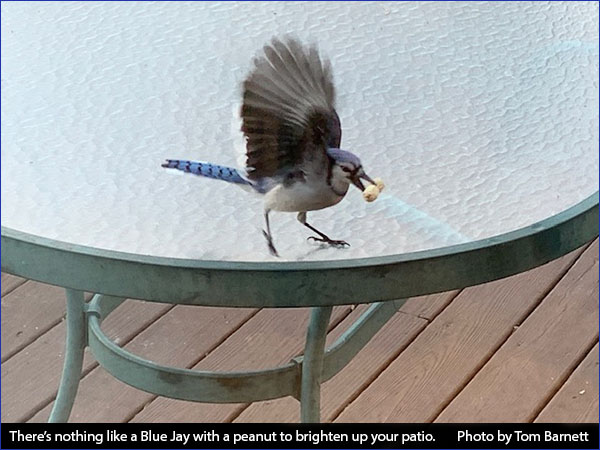
 Mockingbird—Its feather is commonly found on the ground as well. It’s identifiable with its charcoal and white-striping. White patches on the wing are seen in flight or when the male struts while spreading and stretching his wings during territorial displays. The 11-inch long bird mimics other birds and machines (even car alarms) with its repetitions. Its Latin name, Mimus polyglottos, means many-tongued mimic. The non-migratory bird lives in the warmer climates of the United States, except for New England. It will swoop down on passersby or snoopers coming too close to its nest or territory. Research claims its middle-of-the-night call comes from an unmated male, especially during a full moon or mating season.
Mockingbird—Its feather is commonly found on the ground as well. It’s identifiable with its charcoal and white-striping. White patches on the wing are seen in flight or when the male struts while spreading and stretching his wings during territorial displays. The 11-inch long bird mimics other birds and machines (even car alarms) with its repetitions. Its Latin name, Mimus polyglottos, means many-tongued mimic. The non-migratory bird lives in the warmer climates of the United States, except for New England. It will swoop down on passersby or snoopers coming too close to its nest or territory. Research claims its middle-of-the-night call comes from an unmated male, especially during a full moon or mating season.
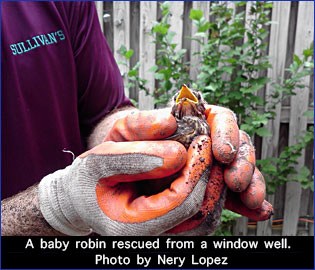 Robin—Like the Catbird, this thrush will hop along freshly excavated soil in search of earthworms ... unlike male birds which sing when identifying territory or courting a mate, the male robin sings to announce the birth of its newborn ... the male has a black head while the female’s is pale gray ... the male’s breast is a deeper red ... both sexes have a white eyeliner broken on the sides and a yellow bill ... its call is a “cheery-up,” a fragile but happy melody ... the eggs are a distinctive greenish-blue up to seven in one clutch ... Robins live only two years and only 25 percent survive their first summer ... females build a cup-like nest lined on the inside with mud.
Robin—Like the Catbird, this thrush will hop along freshly excavated soil in search of earthworms ... unlike male birds which sing when identifying territory or courting a mate, the male robin sings to announce the birth of its newborn ... the male has a black head while the female’s is pale gray ... the male’s breast is a deeper red ... both sexes have a white eyeliner broken on the sides and a yellow bill ... its call is a “cheery-up,” a fragile but happy melody ... the eggs are a distinctive greenish-blue up to seven in one clutch ... Robins live only two years and only 25 percent survive their first summer ... females build a cup-like nest lined on the inside with mud.
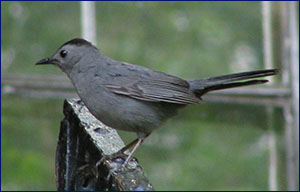 Catbird—Slate gray with a black cap, this bird imitates a crying cat ... when confronted by a predator, it will flash its wings and may attack ... in our line of work, the Catbird is a friend not a foe and will wait nearby as the earth is turned to pursue a meal of insects and spiders ... up to 9 inches long and has a rust spot underneath its tail ... it has a matching black bill and eyes ... like the Mockingbird, it will mimic other birds’ calls as well as machinery.
Catbird—Slate gray with a black cap, this bird imitates a crying cat ... when confronted by a predator, it will flash its wings and may attack ... in our line of work, the Catbird is a friend not a foe and will wait nearby as the earth is turned to pursue a meal of insects and spiders ... up to 9 inches long and has a rust spot underneath its tail ... it has a matching black bill and eyes ... like the Mockingbird, it will mimic other birds’ calls as well as machinery.
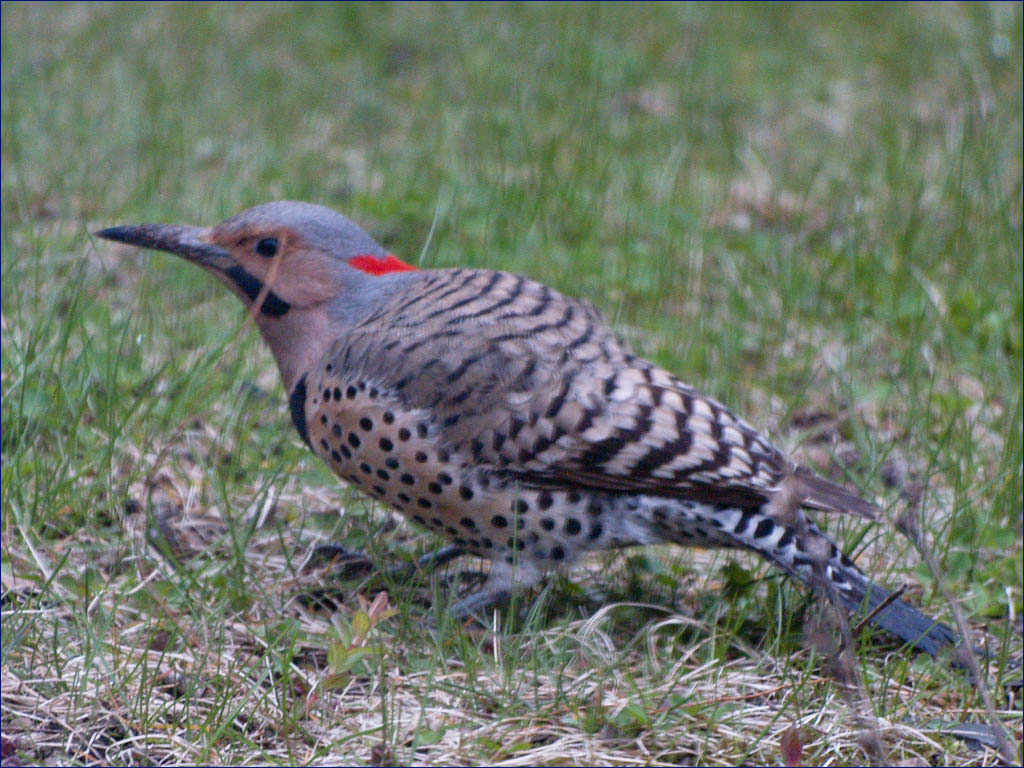 Flicker—Few birds in the landscape have unique markings like the Yellow-shafted Northern Flicker, a 13-inch-long member of the woodpecker family ... it has an ivory and beige breast with prominent black circles, a black (smile-like) necklace, beige back with black flecks and a red patch on the back of the neck ... the tail is dark on top and the rump is white, best seen in flight ... its’ call is a “kee-kee-kee” and “woika” during courtship ... half of its diet is ants ... state bird of Alabama.
Flicker—Few birds in the landscape have unique markings like the Yellow-shafted Northern Flicker, a 13-inch-long member of the woodpecker family ... it has an ivory and beige breast with prominent black circles, a black (smile-like) necklace, beige back with black flecks and a red patch on the back of the neck ... the tail is dark on top and the rump is white, best seen in flight ... its’ call is a “kee-kee-kee” and “woika” during courtship ... half of its diet is ants ... state bird of Alabama.
 Barred Owl—The one and only time I came "face to face" with this creature was in Fairfax Station. We were ready to leave a job site when I returned to the back yard to see if any tools were left behind. As I dipped under a low-branching Dogwood, a swooping sound knocked me to the ground. When I looked up from my knees, I saw the largest bird ever flapping its way to a large Oak tree.
Barred Owl—The one and only time I came "face to face" with this creature was in Fairfax Station. We were ready to leave a job site when I returned to the back yard to see if any tools were left behind. As I dipped under a low-branching Dogwood, a swooping sound knocked me to the ground. When I looked up from my knees, I saw the largest bird ever flapping its way to a large Oak tree.
I was hoping it would stay and it did, roosting on a branch 15 feet from the ground before turning around and staring at me. Very eerie. It was about 16 inches long and fat. Its brown eyes matched the dark brown stripes on its chest. Supposedly nocturnal, this creature was out for an early appetizer. It made no sound, just starred at me while it dipped its head down to survey the ground.

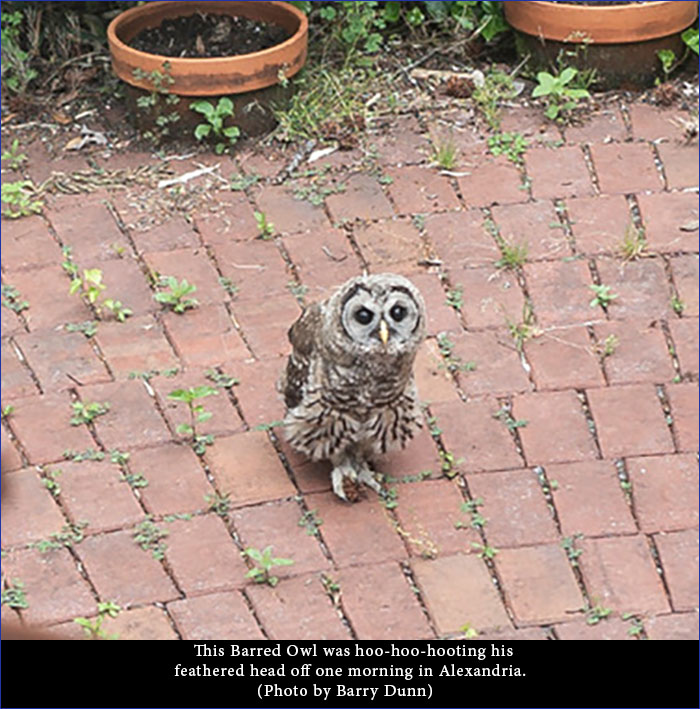
Canada Goose—A flock regularly feeds on a grass field at the corner of Quaker Lane and Seminary Road in Alexandria. I’ve encountered them on golf courses while searching for my ball in tall marsh grass at a pond’s edge. One time, Mother Goose charged and hissed at me since I was approaching her nest area. Lovely in flight, you can hear their muted honking from quite a distance.

Crow—There are over 30 types of the big black bird whose “Caaw, Caaw” is distinctive yet alarming. When it belts it, the bird resembles a hound dog in that it thrusts its body forward while jerking its head skyward.
The crow commonly is known as a “raven.” The National Football League’s Baltimore team is nicknamed the Ravens seeing how Edgar Allen Poe is a native of the “Charm City.” Poe’s 1845 poem, “The Raven” features a narrator engaged in complex conversation with a pseudo-prophetic raven.
 While we’re into nicknames, Baltimore also is referred to as “Crab Town,” “Monumental City” and “Charm City.”
While we’re into nicknames, Baltimore also is referred to as “Crab Town,” “Monumental City” and “Charm City.”
The American Crow is seen perching or walking on the ground in search of dead rodents. Up to 20 inches long, its black plumage has iridescent flecks. An omnivore, the crow searches for acorns and walnuts in winter. In farmland, it feasts on wheat, corn and newly planted seeds.
Farmers use scarecrows to ward off the thieves. The most popular one, “Hunk,” was played by Ray Bolger in the 1939 film, “The Wizard of Oz,” where Judy Garland discovers him in a cornfield just off the yellow brick road.
Mourning Dove—So named due its brooding “coooo” call, this 12-inch-long, big-bellied bird is different from a Rock Dove, known as the pigeon. The watery “orrr” is the male calling to the female.
The tamest bird in existence, it waddles along window sills and calls for entry while its head bobs to look through the glass. I’ve seen it nesting on a patio shelf and inside a coiled garden hose. A customer once found it nesting in a flower pot. She was able to pet the parent while it sat on its eggs! Most incubating animal mothers attack if confronted.
The dove’s babies or squabs or altricial are undeveloped and helpless, needing nurturing from both parents which take turns resting on the nest eggs. The squabs are reluctant to leave the nest, making for a cramped family condition. Squabs can be the size of a fist.
Monogamous (another thing to like about this beauty), it has buff plumage, light brown wings and dark brown spots on its lower back. Its tail feather and wingtips are brown with white margins. Around the circumference of its eye is a teal stripe. Its feet are pinkish, starfish-shaped and spindly given the robust size of its body.
The bird is prominently featured in the traditional Christmas carol, “The Twelve Days of Christmas.” Six of the gifts from “my true love“ are: a partridge in a pear tre, two turtle doves, three French hens, four calling birds, six geese a-laying and seven swans a-swimming.
The expression “lonesome dove” is an oddity since in the wild, doves usually perch in pairs.
Photos By: Marlene Drucker
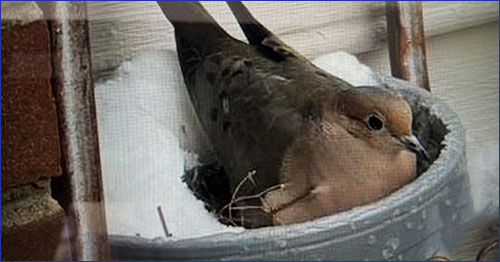
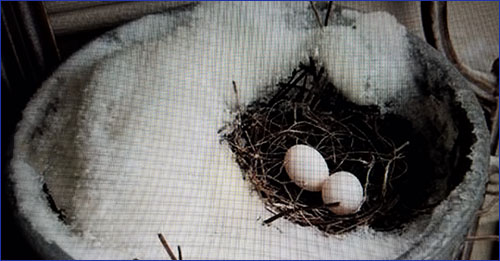
Great Blue Heron—Its yellow Iris matches the color of its bill. Atop its head is a black stripe which extends off the back of the head. Half its bill is silver-colored which matches the plumage of its body. Its black toes radiate like a star-like pattern—suitable for gripping a fallen log or standing in muddy water as it prepares to lower its bill for a fish catch. The upper parts of its spindly legs are a cream color. Its gray neck is almost S-shaped and its head is white. I’ve seen one standing in shallow water in Paul Spring Park in the Hollin Hills area of south Alexandria. And I saw many in Venice, Florida, in February, 2022. Herons step slowly along the ground or in shallow water. Once they take flight, its wingspan stretches to six feet.
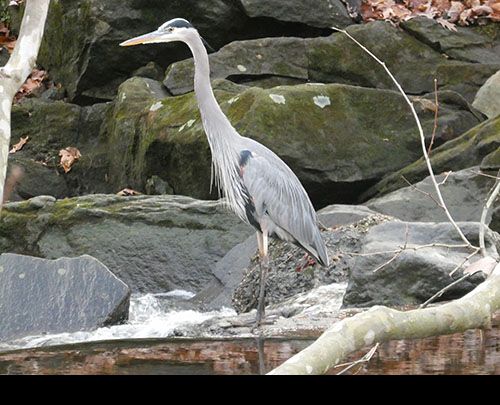
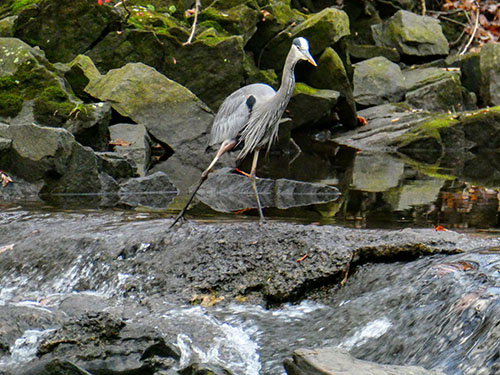
Sequoia National Park
This beauty wasn’t sighted in northern Virginia but in Sequoia National Park in California. A customer of mine in Alexandria took this picture in June of 2022. She said, “This guy walked right up to me.” I’m not sure if this ‘guy’ is a deer, elk, caribou or reindeer.

